Private Cloud Appliance - The Best Virtualization and Private Cloud for Datacenters
The main IT problem for enterprises today is the increase in operating expenses. According to IDC, 70% of operating expenses for IT are associated with the operation of data centers, while 80% of IT personnel are engaged in supporting the existing infrastructure. The other side of this problem is that the complexity of the data center does not allow you to flexibly respond to changes in business requirements, as a result of which the enterprise IT system began to slow down the development of the business. All this led to the fact that the business began to look for ways to reduce operating costs for IT, and manufacturers to offer such systems.

We have already done a general review of the hardware and software systems, and today we will talk about the Oracle Private Cloud Appliance (Fig. 1), a system that combines computing, network, storage and virtualization, both computing and network. Private Cloud Appliance runs on all popular x86 OC Linux, Windows, Solaris x86 operating systems. As we wrote earlier, each hardware-software complex is the result of careful design, selection of components, software configuration and optimization. Because of this, it takes exactly one hour to deploy the Private Cloud Appliance firmware. When expanding the complex, servers are added to it as system resources with automatic detection and installation. The complex has a single management console based on a web interface. Virtual Compute Appliance management - installation, resource allocation, virtual machine deployment, integration with external systems and storage systems - is fully automated. Any x86-based applications run on the Virtual Compute Appliance without modifications.
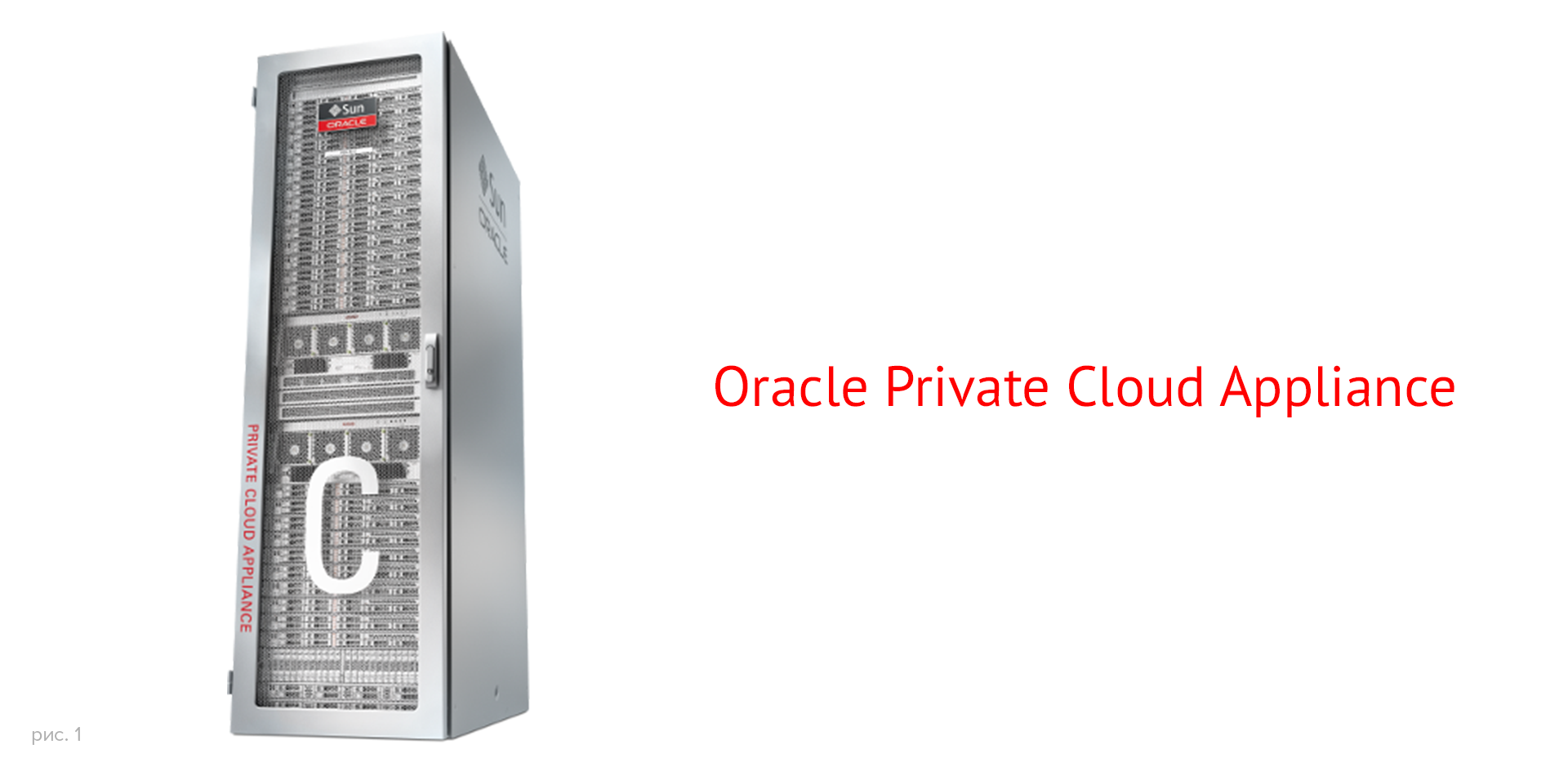
Virtual machines from Oracle VM templates are deployed very quickly. For example, in order to deploy an Oracle Real Application Cluster cluster from an Oracle VM-template, you need 10 times less time than on VMware vSphere 5.
Let's see how the Private Cloud Appliance software and hardware complex works, on which it all works so fast .
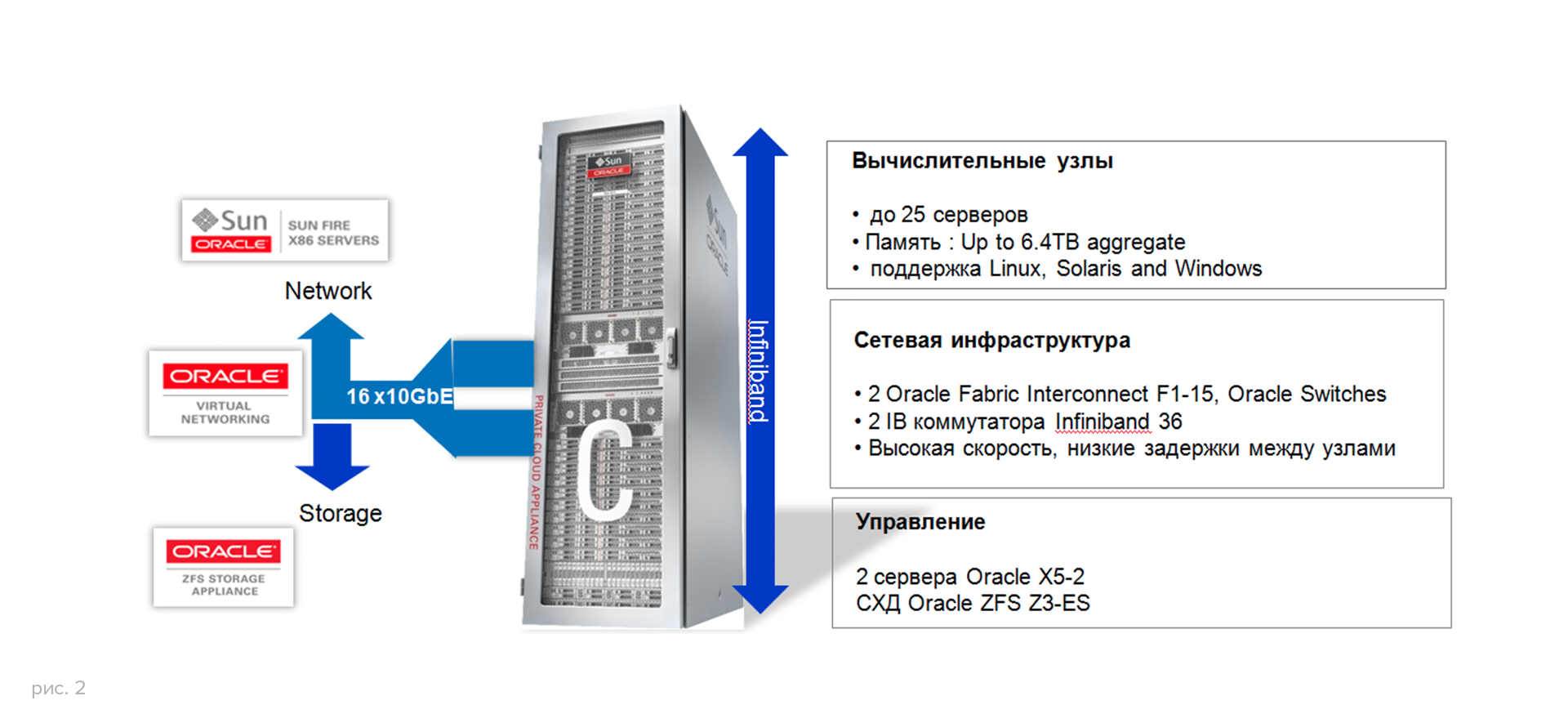
The Private Cloud Appliance software and hardware complex is based on the following components:
The server farm is running on dual-socket Oracle X5-2 nodes with Intel E5-2699 v3 processors (18 core). We call the internal storage of 20 disks of 900 GB (18 TB) a system disk, its main purpose is the storage of installation images and software for managing the software and hardware complex. There are 6 TB available on this storage system, which the user can use at his own discretion, including for virtual machines, although we recommend using an external storage system for storing the virtual farm.
For network virtualization, Oracle Virtual Networking (OVN) intranet virtualization technology is used. Unlike the classic complex switching structure, Oracle uses an intermediate layer - Oracle Fabric Interconnect, all switching is carried out through a high-speed (every connection - 40 Gbit / s) switched Infiniband network (Fig. 3). This not only greatly simplifies the physical structure of the hardware and software complex, but also makes it possible to use a completely new functionality - configure the quality of service (QoS) for the predictable operation of applications, migrate virtual adapters from server to server and create new networks.
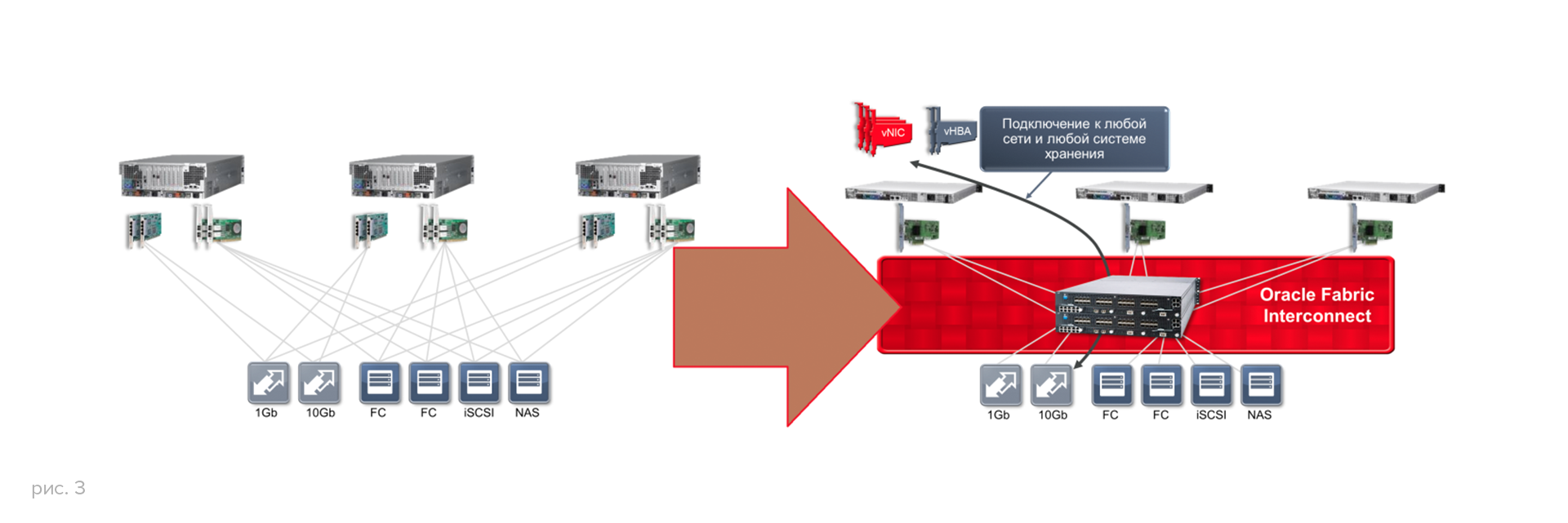
In addition, Oracle Software Defined Network (SDN) functionality is included in the Private Cloud Appliance - a system for creating private networks without OVN. An agent runs on the servers, which creates an internal network between virtual adapters, without using an OVN switch. The software defined network operation diagram is shown in fig. 4.
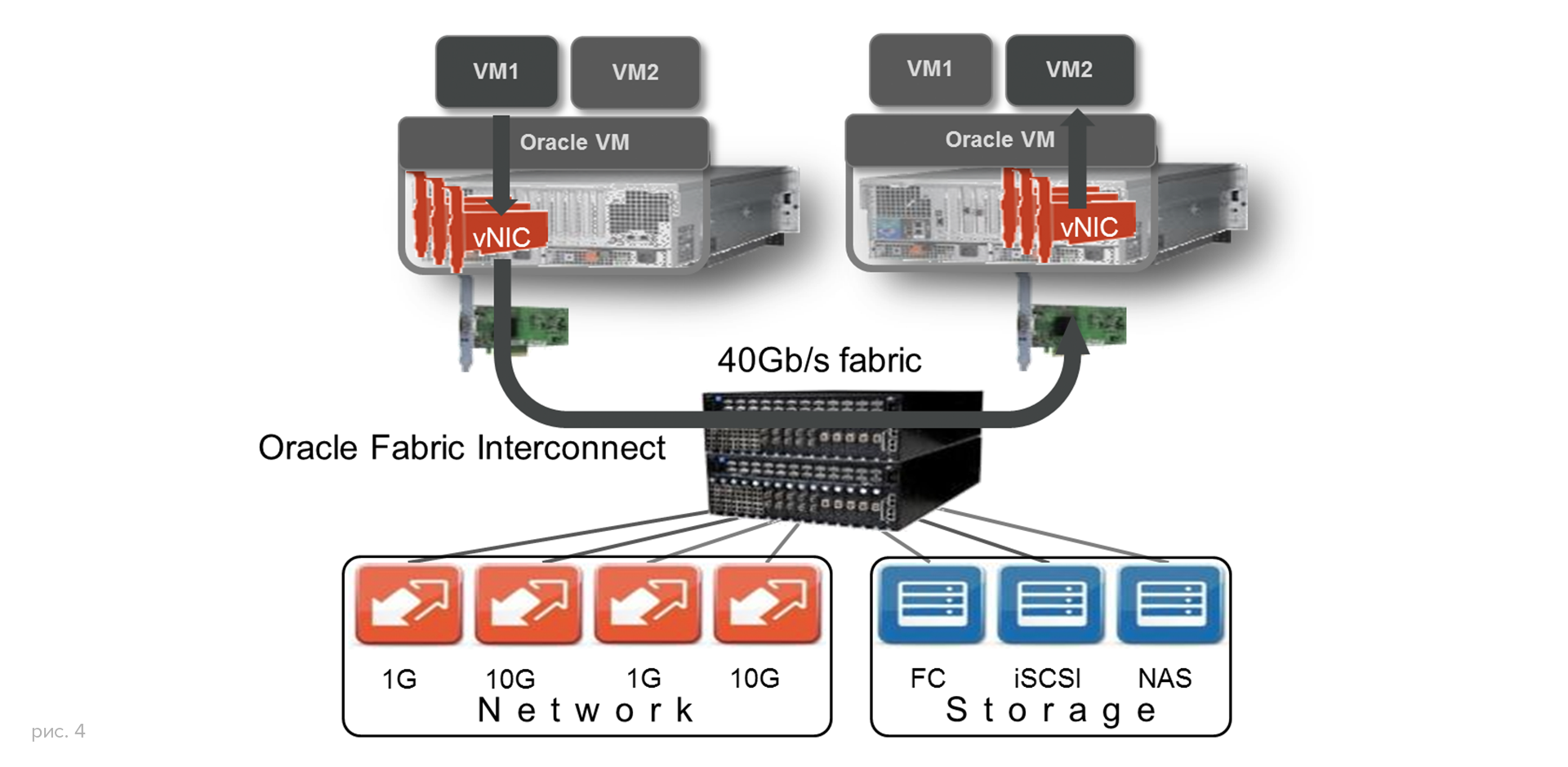
SDN together with Infiniband (IB) switching provides very high performance in the operation of clusters, applications, during the migration of virtual machines and allows you to configure the quality of service using QoS policies. Since a regular Ethernet network is used, there is no need to modify the network stack.
All internal switching of network nodes and the storage system is performed using two IB switches connected to Fabric Interconnect F1-15, through which there is communication with an external data center and external storage systems (Fig. 5). At the same time, the customer sees only 16 10 Gb Ethernet interfaces for connecting to the data center network and external storage systems, network management and interfaces (IB and FC) for connecting to external data storage systems.
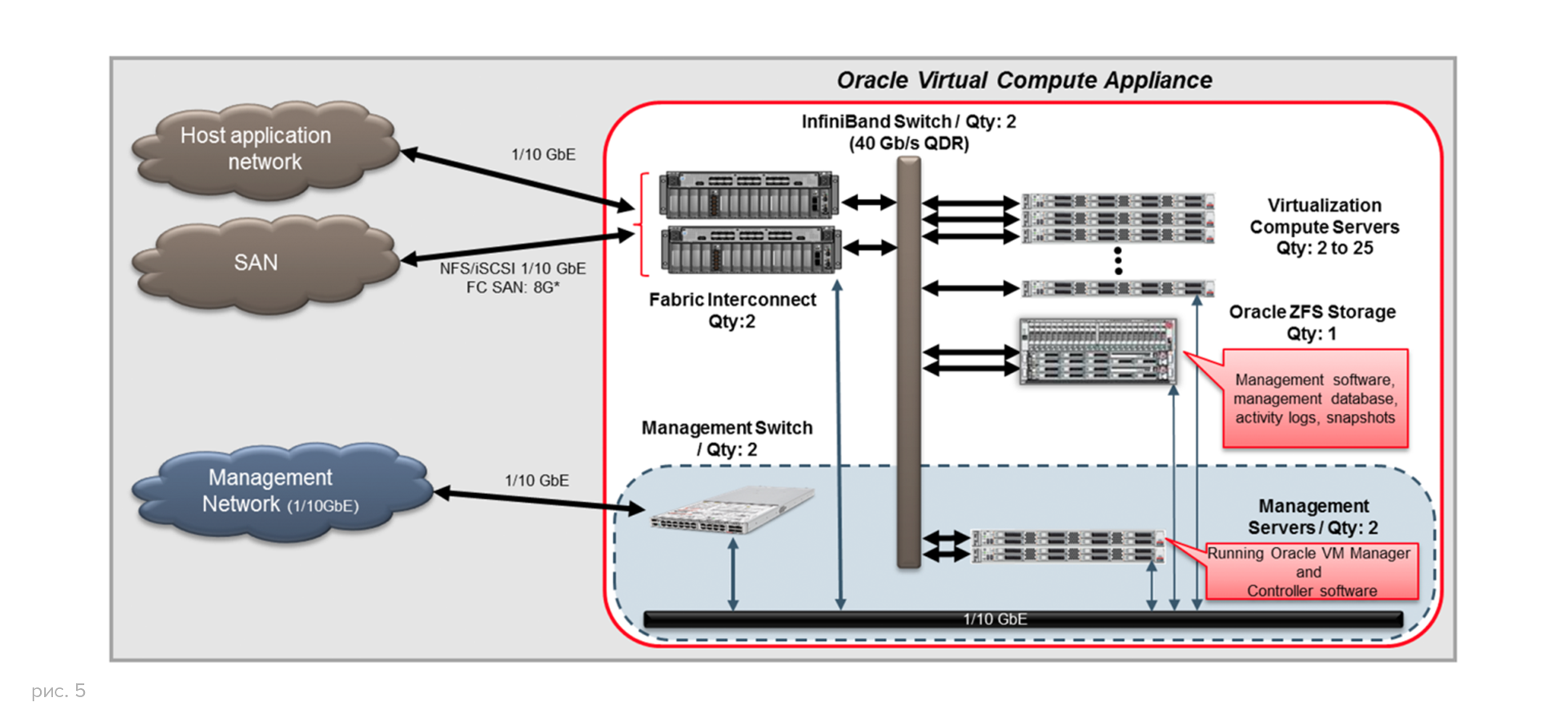
System administration is performed by two different users: one user manages the equipment, the second user manages the virtual farm, configures and maintains the virtual machines.
As can be seen from fig. 6, the software structure of the Virtual Compute Appliance consists of four layers:

The virtualization hypervisor used in PCA is Oracle VM for X86. It is implemented on the basis of Xen and has all the necessary functionality for working with a virtual farm.
The balancing mechanism of virtual machines in the pool provides automatic movement of virtual machines from the most loaded nodes to the least loaded. The inverse problem is also being solved: if it is required to utilize physical machines in the pool more densely to save energy, virtual machines are “compacted” on a limited number of nodes, and the released nodes can be disabled.
Ready-made virtual machine templates are downloaded from the Oracle website, which greatly speeds up the work with the system. These are pre-installed and configured virtual machines - complete installations of applications, application servers, databases.
The PCA offers a major cost advantage with Oracle Trusted Partitioning licensing policies. This policy allows the user to license on the PCA only the number of cores on Oracle that will be used by this application throughout the virtual farm. For example, a PCA virtual farm consists of 5 nodes (5 × 36 = 180 cores), Oracle DB uses 20 cores, and the rest uses other applications. The customer will have to buy licenses only for these 20 cores (10 licenses) and use them throughout the virtual farm, without reference to specific CPUs. In the case of VMware, I would have to buy licenses for all 180 cores (90 licenses).
It is planned to expand the scaling of PCA with expansion racks with computing nodes, which will increase the size of virtual farms and the range of application of this engineering system.
According to IDC 2015, global costs for hardware and software systems will increase from $ 4 billion in 2013 to $ 13.2 billion in 2018, with 15% of all systems purchased as hardware and software systems. It is important to understand that only Oracle provides a fully integrated stack for software and hardware systems, including the operating system, hypervisor, and applications that can run on this system. So for Oracle, this means a huge jump in demand for its hardware and software systems, and for you - an occasion to get to know them better.

We have already done a general review of the hardware and software systems, and today we will talk about the Oracle Private Cloud Appliance (Fig. 1), a system that combines computing, network, storage and virtualization, both computing and network. Private Cloud Appliance runs on all popular x86 OC Linux, Windows, Solaris x86 operating systems. As we wrote earlier, each hardware-software complex is the result of careful design, selection of components, software configuration and optimization. Because of this, it takes exactly one hour to deploy the Private Cloud Appliance firmware. When expanding the complex, servers are added to it as system resources with automatic detection and installation. The complex has a single management console based on a web interface. Virtual Compute Appliance management - installation, resource allocation, virtual machine deployment, integration with external systems and storage systems - is fully automated. Any x86-based applications run on the Virtual Compute Appliance without modifications.

Virtual machines from Oracle VM templates are deployed very quickly. For example, in order to deploy an Oracle Real Application Cluster cluster from an Oracle VM-template, you need 10 times less time than on VMware vSphere 5.
Let's see how the Private Cloud Appliance software and hardware complex works, on which it all works so fast .
Hardware

The Private Cloud Appliance software and hardware complex is based on the following components:
- Control system: a pair of x86 systems, which we call controllers;
- Computing farm: two to 25 nodes
- Storage System: ZFS ZS3-2;
- Network Infrastructure: F1-15 Network Virtualization System, IB Switching and Management
The server farm is running on dual-socket Oracle X5-2 nodes with Intel E5-2699 v3 processors (18 core). We call the internal storage of 20 disks of 900 GB (18 TB) a system disk, its main purpose is the storage of installation images and software for managing the software and hardware complex. There are 6 TB available on this storage system, which the user can use at his own discretion, including for virtual machines, although we recommend using an external storage system for storing the virtual farm.
For network virtualization, Oracle Virtual Networking (OVN) intranet virtualization technology is used. Unlike the classic complex switching structure, Oracle uses an intermediate layer - Oracle Fabric Interconnect, all switching is carried out through a high-speed (every connection - 40 Gbit / s) switched Infiniband network (Fig. 3). This not only greatly simplifies the physical structure of the hardware and software complex, but also makes it possible to use a completely new functionality - configure the quality of service (QoS) for the predictable operation of applications, migrate virtual adapters from server to server and create new networks.

In addition, Oracle Software Defined Network (SDN) functionality is included in the Private Cloud Appliance - a system for creating private networks without OVN. An agent runs on the servers, which creates an internal network between virtual adapters, without using an OVN switch. The software defined network operation diagram is shown in fig. 4.

SDN together with Infiniband (IB) switching provides very high performance in the operation of clusters, applications, during the migration of virtual machines and allows you to configure the quality of service using QoS policies. Since a regular Ethernet network is used, there is no need to modify the network stack.
Commutation
All internal switching of network nodes and the storage system is performed using two IB switches connected to Fabric Interconnect F1-15, through which there is communication with an external data center and external storage systems (Fig. 5). At the same time, the customer sees only 16 10 Gb Ethernet interfaces for connecting to the data center network and external storage systems, network management and interfaces (IB and FC) for connecting to external data storage systems.

System administration is performed by two different users: one user manages the equipment, the second user manages the virtual farm, configures and maintains the virtual machines.
Software
As can be seen from fig. 6, the software structure of the Virtual Compute Appliance consists of four layers:
- The automation and control layer located on the controllers: it is responsible for the physical work of the system - turning on the equipment, installing, administering the server, network discovery, backing up the system configuration to external and internal storage.
- Network virtualization layer: Oracle Software Defined Network, Fabric Monitor, and Oracle Fabric Manager.
- The server virtualization layer implemented on Oracle VM Server: is responsible for creating virtual ones manually or through templates, centralizing all servers and managing virtualization (migration of running virtual machines, load balancing throughout the entire hardware and software complex, automatic restart of failed virtual machines, automatic shutdown of free policy-based nodes).
- Guest Layer: Oracle Linux, Windows, Solaris x86.

The virtualization hypervisor used in PCA is Oracle VM for X86. It is implemented on the basis of Xen and has all the necessary functionality for working with a virtual farm.
The balancing mechanism of virtual machines in the pool provides automatic movement of virtual machines from the most loaded nodes to the least loaded. The inverse problem is also being solved: if it is required to utilize physical machines in the pool more densely to save energy, virtual machines are “compacted” on a limited number of nodes, and the released nodes can be disabled.
Ready-made virtual machine templates are downloaded from the Oracle website, which greatly speeds up the work with the system. These are pre-installed and configured virtual machines - complete installations of applications, application servers, databases.
Trusted Partitioning Licensing Features
The PCA offers a major cost advantage with Oracle Trusted Partitioning licensing policies. This policy allows the user to license on the PCA only the number of cores on Oracle that will be used by this application throughout the virtual farm. For example, a PCA virtual farm consists of 5 nodes (5 × 36 = 180 cores), Oracle DB uses 20 cores, and the rest uses other applications. The customer will have to buy licenses only for these 20 cores (10 licenses) and use them throughout the virtual farm, without reference to specific CPUs. In the case of VMware, I would have to buy licenses for all 180 cores (90 licenses).
Future plans
It is planned to expand the scaling of PCA with expansion racks with computing nodes, which will increase the size of virtual farms and the range of application of this engineering system.
According to IDC 2015, global costs for hardware and software systems will increase from $ 4 billion in 2013 to $ 13.2 billion in 2018, with 15% of all systems purchased as hardware and software systems. It is important to understand that only Oracle provides a fully integrated stack for software and hardware systems, including the operating system, hypervisor, and applications that can run on this system. So for Oracle, this means a huge jump in demand for its hardware and software systems, and for you - an occasion to get to know them better.
